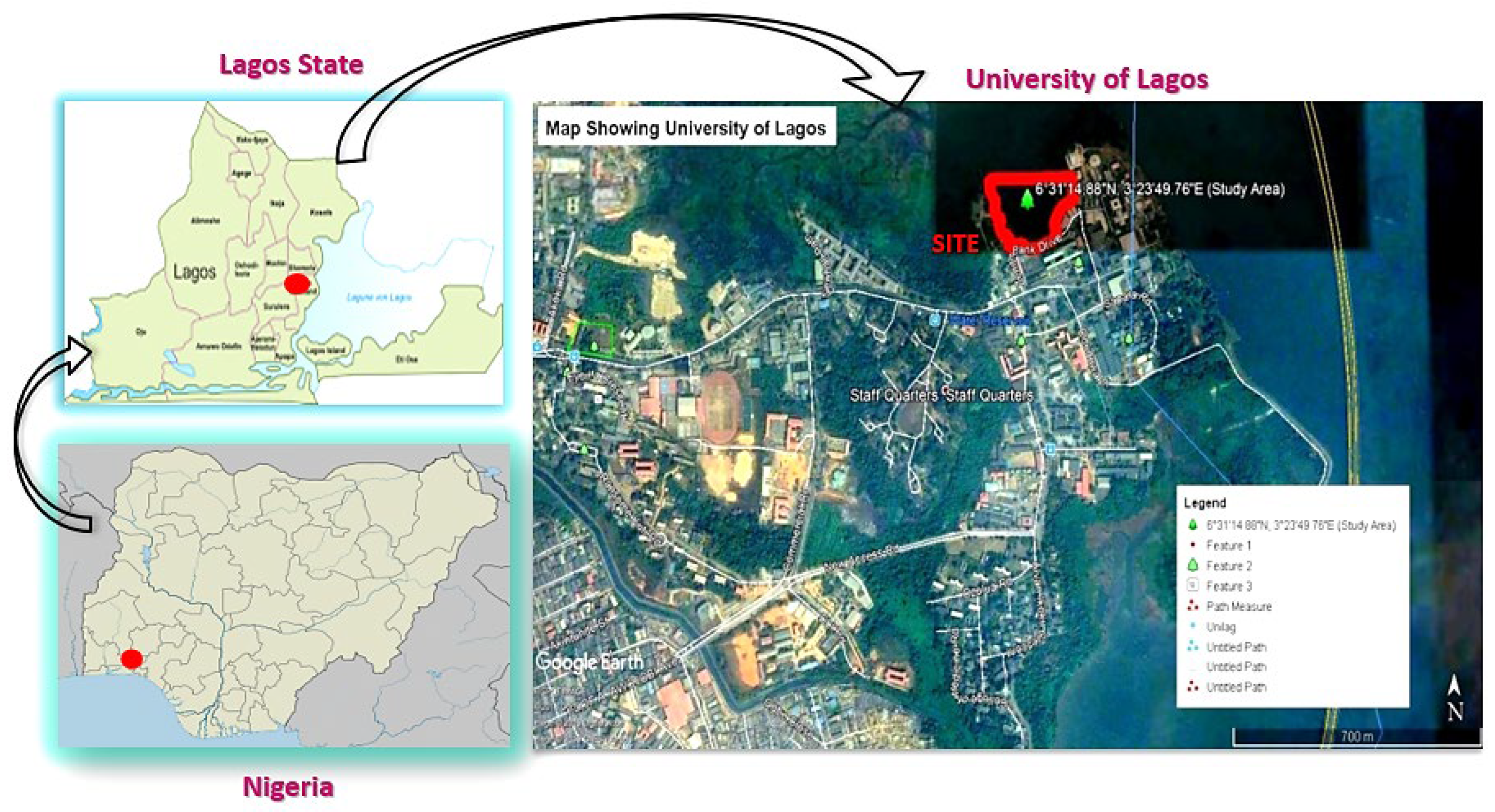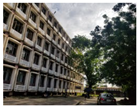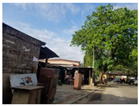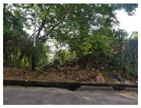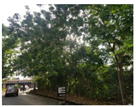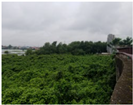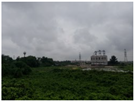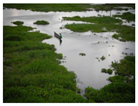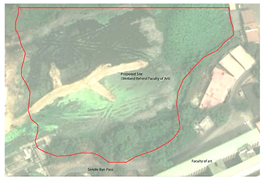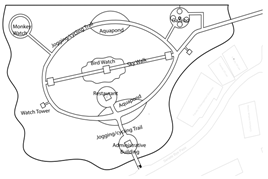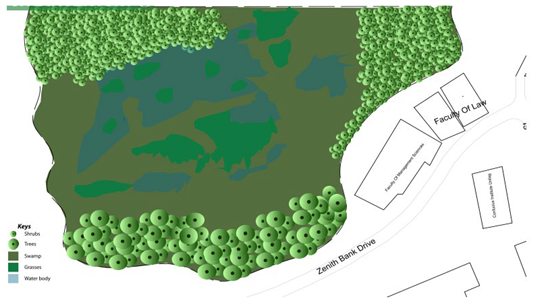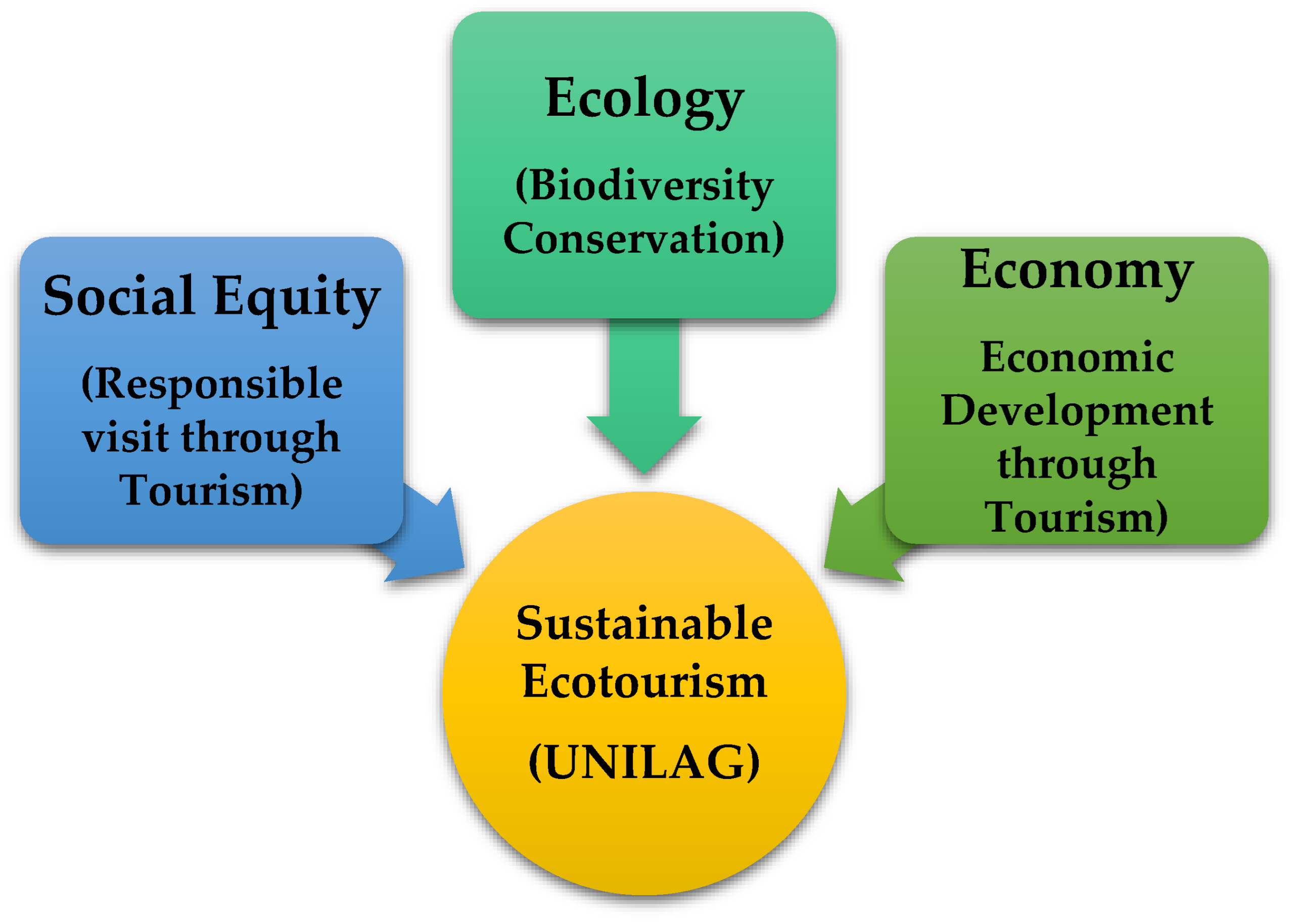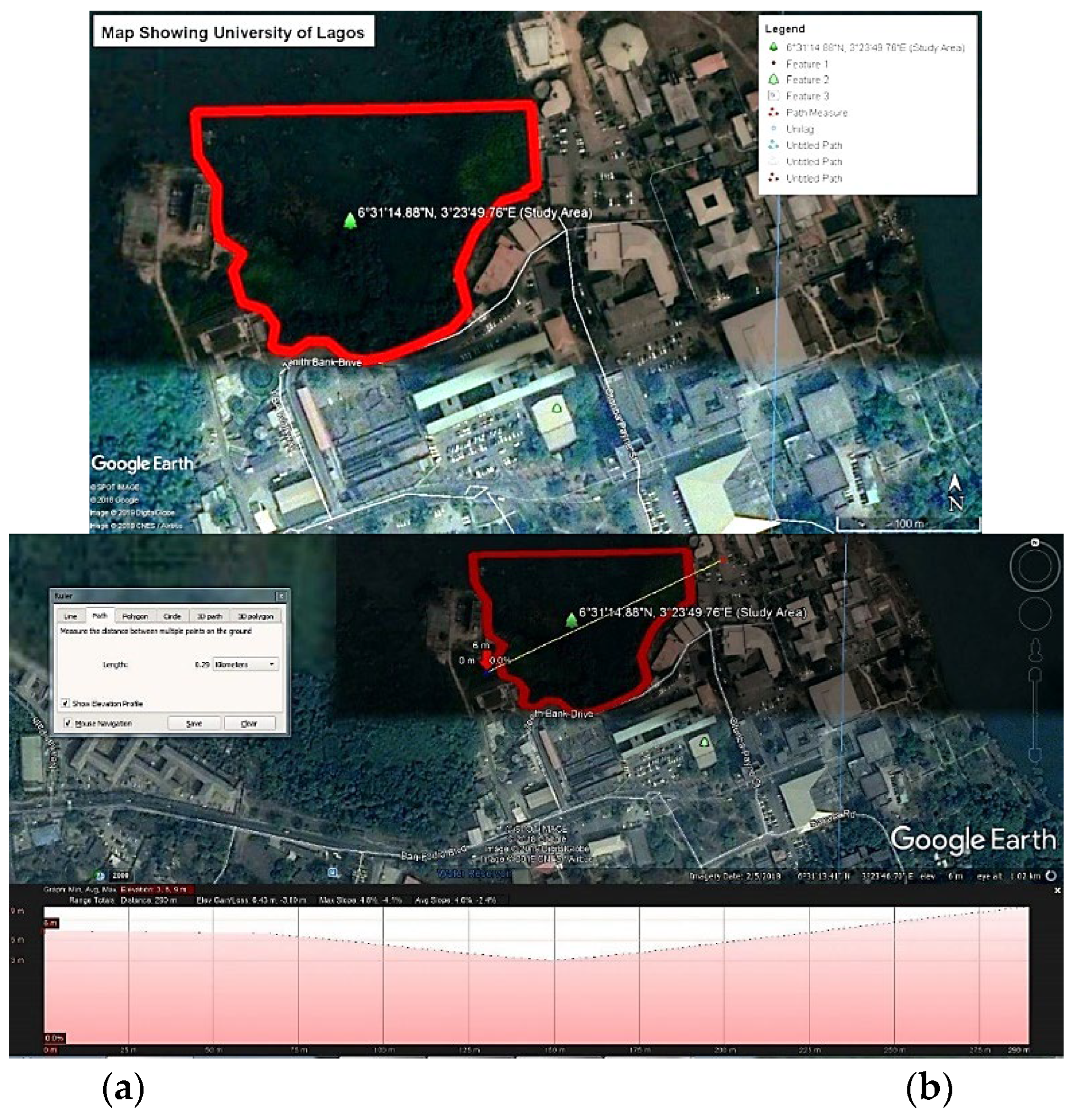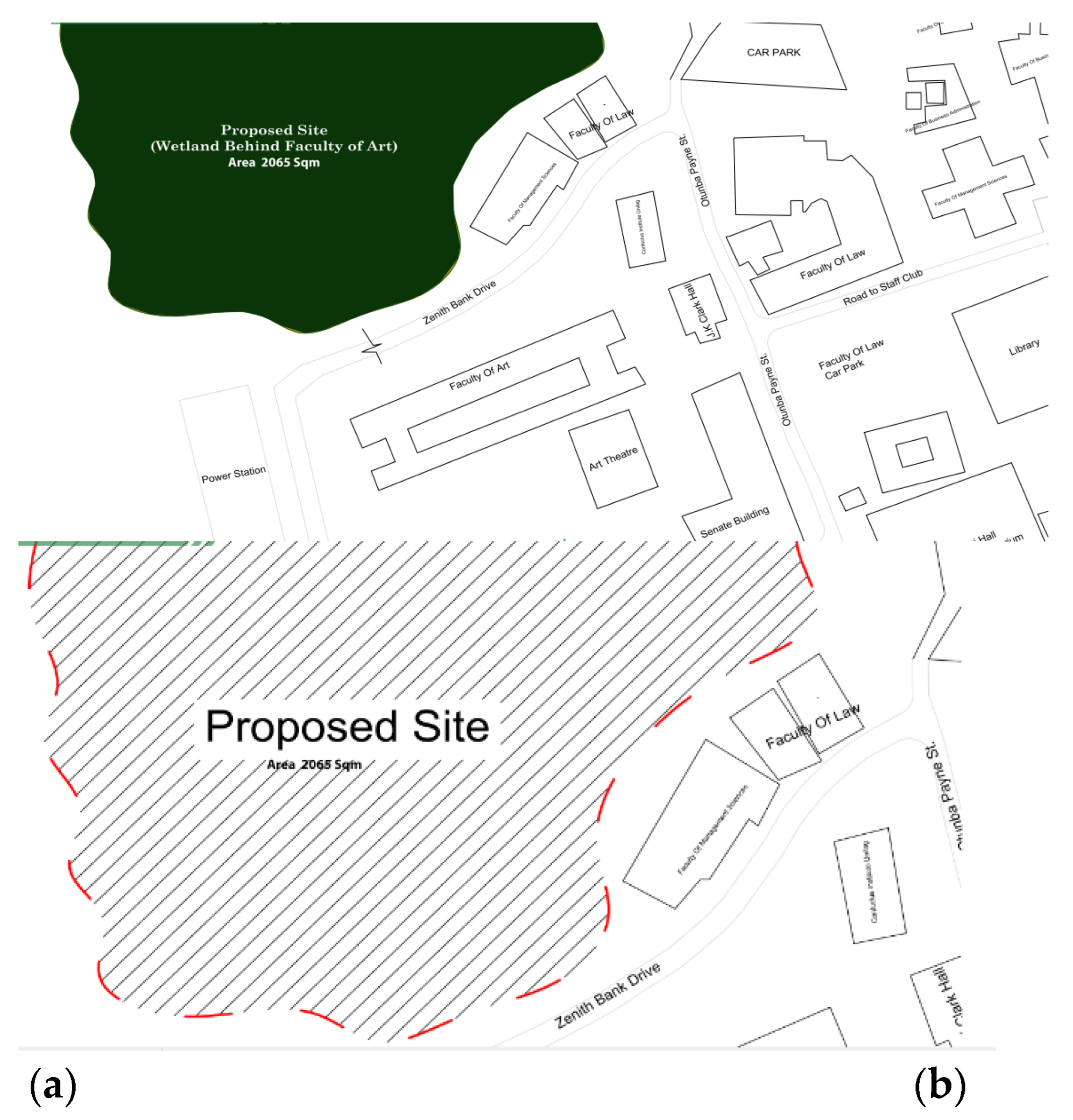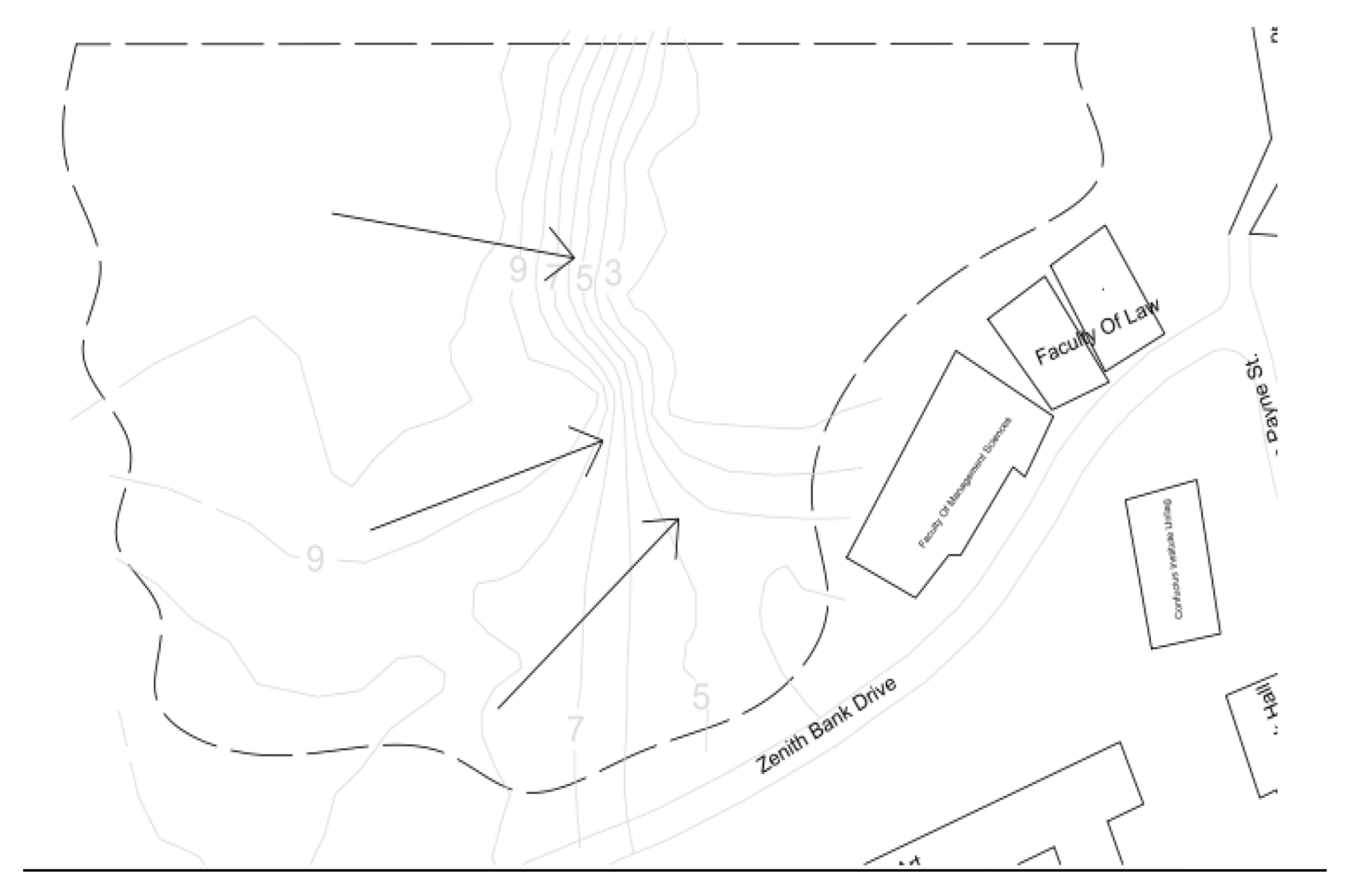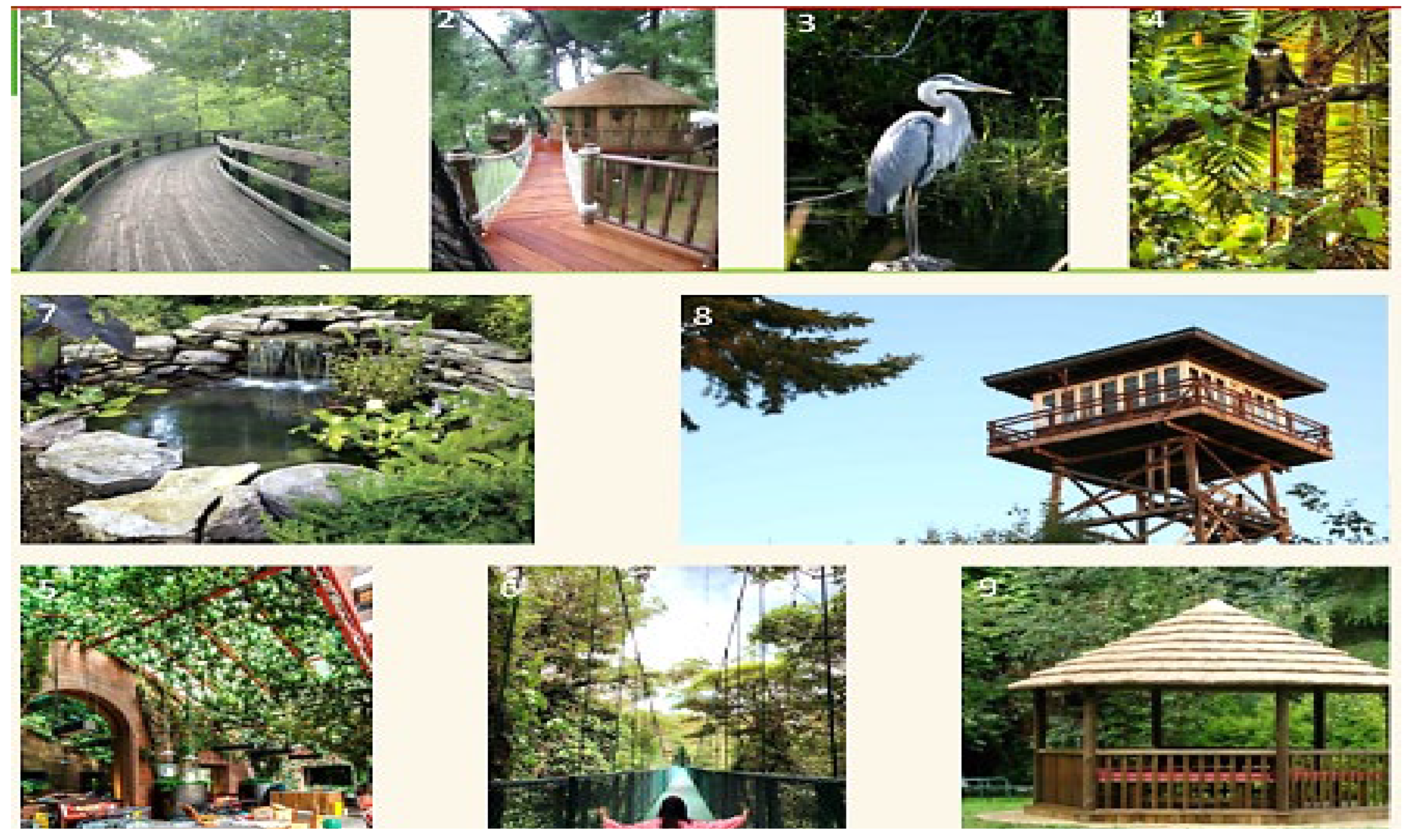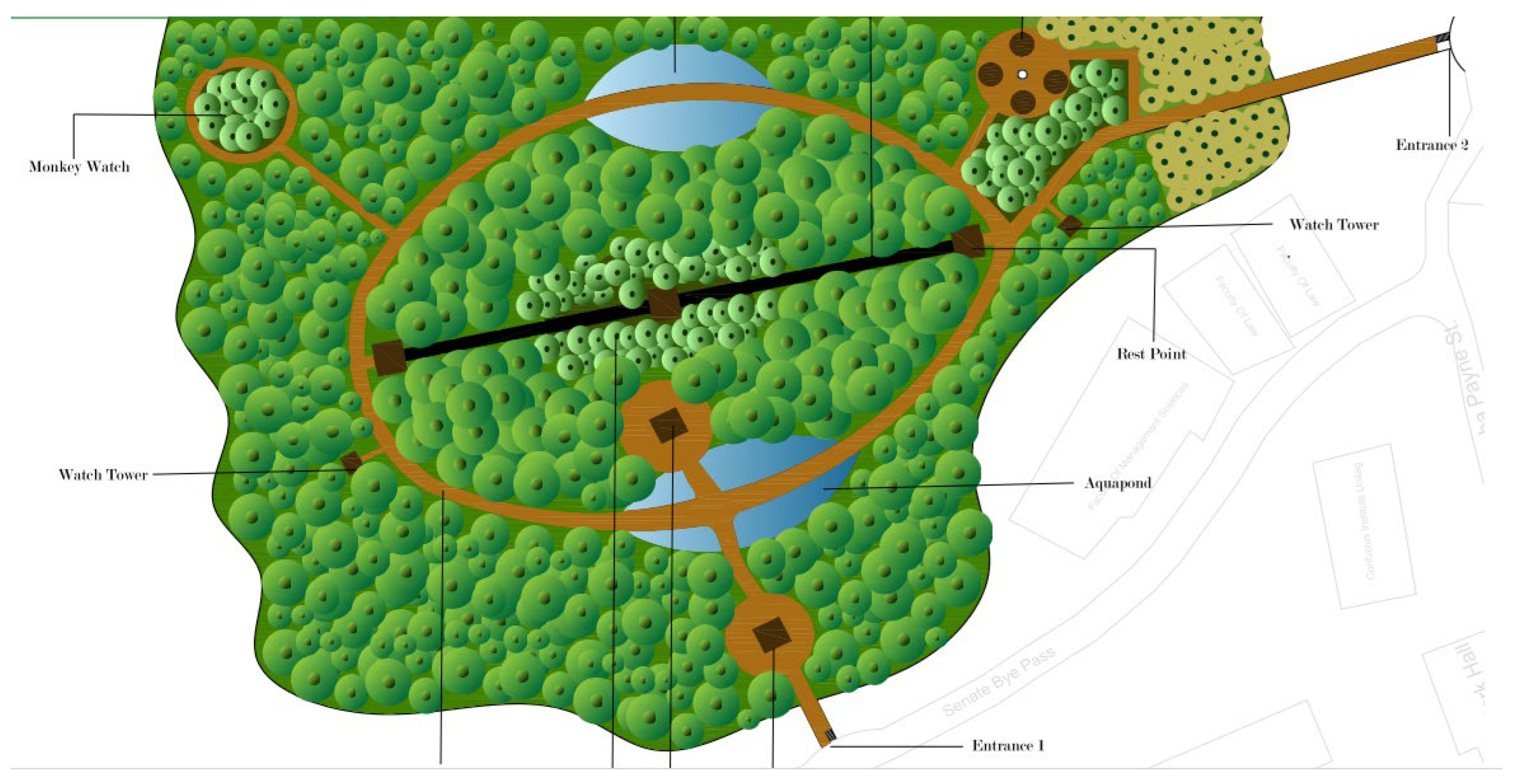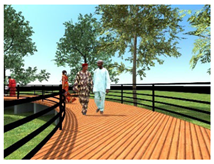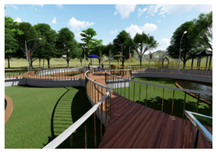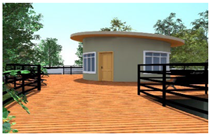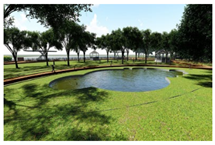1. Introduction
The entire ecological consciousness of our country is essential to healthy tourist access since it will have a big impact on how we promote universities and colleges internationally. Only when institutions such as a university with distinct green credentials for all of the surrounding towns appreciate and restore the degraded landscapes, it would serve as a template for the host town or city. The "University of First Choice" and the Nation's pride as an appropriate destination for travelers will be the full potential of our tourism sector. Restoration of wetlands is becoming more and more popular, especially as a means of mitigating and adapting to climate change [
1,
2]. In addition to providing compensation for direct biodiversity losses connected with the people and the city at large, wetlands are occasionally built and restored for a variety of purposes [
3]. Restoration of wetlands involves restoring their natural functions by modifying their deteriorating or previous physical, chemical, or biological features [
4,
5,
6,
7].
A deep comprehension of the ecosystem dynamics of the system being restored as well as a complete grasp of the environmental needs of both plants and animals are essential for wetland restoration [
6]. The purpose of this study is to investigate sustainable frameworks for restoring the wetlands to facilitate ecotourism. This wetland is behind three outstanding faculties in the University of Lagos; Faculty of Arts, Faculty of Law, and Faculty of Management Sciences. The study has several advantages, including raising residents' knowledge of environmental issues, directly funding conservation efforts, and giving them financial support and self-determination through research. The study's primary draws include the local plants and animals and in pursuit of this goal, the following will be looked into: identifying biodiversity surrounding the campus; fostering sustainable ecotourism on campus; improving sustainable tourism experiences; augmenting the university's economy through ecotourism; expanding access to green outdoor open spaces; lowering campus temperatures; improving air quality; and safeguarding and enhancing ecological goods and services with their natural surroundings. According to the World Tourism Organization, sustainable tourism is defined as "travel that promotes resource management in a way that fulfills social, cultural, and economic demands while preserving biological diversity, vital ecological processes, and life support systems" [
8]. Benefiting host communities socioeconomically is a crucial aspect of sustainable ecotourism and it can also be stated differently that, the people who stand to gain the most from tourism should be those who live in and around the destination [
9,
10].
2. Literature Review
Today, ecotourism is described as "conscientious travel to places of natural beauty which includes assessment and learning, protects the natural world, and supports the health and happiness of the indigenous inhabitants" [
11]. Ecological conservation, biodiversity preservation, local revitalization and renewal, and environmentally friendly travel are all part of ecotourism [
11,
12]. The aforementioned ecotourism guidelines should therefore be followed by everyone who develops, engages in, or markets ecotourism-related activities. Studies reveal that the effects of ecotourism are reduced in terms of the environment, people, society, behavior, and psychology that is to say the local dwellers’s perception of the wetlands and green space is important and it increases your respect for and knowledge of the environment and cultures. In addition to offering immediate monetary rewards for conservation efforts, creates wealth for the local community and private sector, and ensures that both guests and hosts have enjoyable stays [
13]. A distinctive approach to creating a welcoming environment inside and outside the institution and its surroundings is based on the concepts of ecotourism hospitality. The tourism industry will extend hospitality to its guests while maintaining and overseeing our culture and the learning atmosphere by upholding these tourism ideals [
14]. Research has also demonstrated that vegetation plays a beneficial role in lessening the negative environmental effects of urban growth [
15]. This is achieved by regulating the temperature, lowering atmospheric carbon dioxide levels, enhancing air quality, reducing runoff from rainfall, decreasing noise pollution, increasing urban energy efficiency, enhancing thermal comfort within buildings, and enhancing the visual appeal of urban areas [
15,
16].
Exploring delicate, impeccable, and largely unaltered natural places is known as ecotourism [
1,
2,
3,
4,
5,
8,
9,
10,
11,
12]. It is a low-impact, frequently small-scale substitute for traditional commercial mass tourism that is common in megacities and urban areas where people travel around for sightseeing [
17]. It entails taking reasonable trips to protected regions, preserving the environment, and enhancing the quality of life for locals and the host communities [
17,
18]. Its goals could include educating tourists, funding environmental preservation, directly assisting local communities' political and economic advancement, and promoting tolerance for other people's cultures and human rights [
10,
11,
12,
13,
14,
15,
16,
17]. Environmentalists have viewed ecotourism as a vital undertaking since the 1980s, believing that it will allow future generations to visit places that have remained mostly unaffected by human involvement [
18,
19]. The notion serves as the practical definition of ecotourism in several academic curricula. It typically involves engaging with the living components of the natural world [
19]. The three main aims of ecotourism are environmental sustainability, human development, and socially conscious travel. Traveling to conserved and protected areas and national parks usually entails visiting places where the main draws are the flora, animals, and cultural legacy. It aims to increase visitor respect for our natural environments and provide insight into how humans affect the planet [
10,
11,
12].
Depicted in
Figure 1 are the preservation of the environment, human development, as well as socially conscious travel. Traveling for ecotourism usually entails visiting places where the main draws are the flora, animals, and cultural legacy. It involves increasing visitor awareness of our natural environment through responsible tourism and providing insight into how humans affect the environment [
20]. Programs that promote the cultural integrity of the community and reduce the detrimental effects of traditional tourism on the environment are examples of responsible ecotourism (see
Figure 1) [
19,
20]. Therefore, promoting, wetlands restoration, streetscaping, recycling, energy efficiency, and the provision of economic opportunities for the locals are essential components of ecotourism, in addition to analyzing environmental and cultural considerations. These variables make ecotourism a popular choice for people who value social justice and the preservation of the environment [
21].
Other studies opined that going to comparatively unspoiled habitats with the specific goal of appreciating, learning about, and relishing the landscape, its flora and fauna, as well as its cultural aspects, is known as ecotourism [
10,
11,
12,
22]. Wetlands are places where water either lies on top of the soil or is present at or close to the soil's surface throughout the year, sometimes even during the growing season [
23]. Many freshwater and terrestrial plant and animal species can be found in swamps and the extended presence of water fosters the formation of distinctive wetland soils and favorable growing conditions for plants with specialized adaptations [
24]. Programs that promote the cultural appreciation and integrity of the community landscapes and reduce the detrimental effects and abuse and misuse of traditional tourism on the environment are examples of sustainable tourism [
25,
26,
27,
28].
2.1. What is Restoration?
Restoring a damaged or abandoned wetland to its original functions involves modifying its physical, chemical, or biological properties and this process is known as wetland restoration [
29]. Restoration is the process of re-establishing and reconstructing a degraded wetland, and the wetland's functionalities. Eliminating a threat or stopping the deterioration of wetland conditions is the definition of wetland protection [
30]. Volunteer conservation of naturally occurring wetlands is an important component of volunteer wetland restoration, intervention, and protection, in addition to the restoration of endangered ecosystems, the inherent ecosystem service, and species [
29,
31].
How am I protected by the wetland ecosystem? Since they function as organic buffers and green zones that are available. These wetlands can absorb and store large volumes of floodwater, which can help to lessen the frequency and severity of floods in the community (campus). A wetland can normally hold one million gallons of water, or around three acres, submerged three feet under [
8,
12,
13,
14,
15,
16,
17,
18,
19,
20,
21,
22,
23,
24,
25,
26,
27,
28,
32]. When hurricanes or tropical storms hit land, coastal wetlands buffer land from storm surges [
30,
31,
32]. In the Gulf Coast region, storm surge and wind wave activity produced by hurricanes and tropical storms can be significantly and possibly sustainably absorbed by barrier islands, shoals, marshes, and other coastal landscape features [
15].
How do wetlands promote both economic prosperity and the preservation of species' surroundings? To stop drought, forest destruction, open-pit coal mining sites, shortages of water, contamination, loss of plant and animal life, and climatic change-related heat waves in cities, there is a growing acknowledgment worldwide of the role that trees play in restoring degraded landscapes [
31,
32]. To develop a restoration framework for a university's wetland, it is critical to leverage the city's waterways, infrastructure, green spaces, and other links. The multiplicity of uses by humans and the environment are supported by them, and their continued existence affects not only the integrity of the land, air, water, and forest resources but also the standards of life [
34]. The cornerstone of the landscape, ecology, history, and leisure, wetlands forge linkages at the local, regional, national, and global levels [
30,
31,
32,
33,
34]. Outdoor green spaces include school yards, playgrounds, community gathering places, drainage channels, farm settlements, parks and gardens, and sports centers in the community and on university campuses [
12]. The accessibility and coherence of the wetlands and natural spaces that are available are highly valuable hence the need for it to be restored [
33,
34]. These are recreational and ecological pathways that wind through the campus and offer a direct experience with nature [
35]. They are areas you do not need or want to visit, but they have a lot of possibilities to become more sustainable today and in the future [
35,
36].
Organizations that promote the cultural vitality of the community and reduce the detrimental effects of traditional tourism on the environment are examples of responsible ecotourism [
35]. As a result, ecotourism through restoration as stated in this study frequently appeals to proponents of social, economic, and environmental consciousness because it not only considers ecological and historical considerations but also actively promotes reuse and recycling, efficient use of energy, conserving water, and the creation of revenue streams for communities nearby.
3. Materials and Methods
Strengths-Weaknesses-Opportunities-Threats (SWOT) analysis was used in a qualitative and exploratory manner, along with geospatial mapping of the wetlands and streams that connect the Lagos Lagoon was done to evaluate the intrinsic ecological goods and services using a variety of analytical techniques. These included analyzing the land area, current biodiversity, hydrology, and its potential through landscape mapping and analysis. Ecological products and services that can be obtained from the wetlands are listed in the GIS evaluation, biodiversity impact assessment, and analysis. Six steps make up the strategy, which begins with a prospective analysis of the city. A detailed plan for creating a sustainable restored site is derived from the mapping and research. To give an idea of what a restored wetland could look like, a comparison with current wetlands is presented. The acquisition of the base map and the completion of the site inventory will be taken into consideration. The six phases were centered on defining the University's biologically diverse regions and current drainage networks. The current vegetation and drainage network of the campus were documented using secondary data from topographical maps, 2019 satellite pictures from Google, earlier soil and hydrological investigations, and fieldwork. To understand the innate ecological goods and services, the second step included mapping biotopes. flooded stream before desilting efforts. The following factors were taken into account and examined to comprehend the website:
The Landscape Specific features: The site features include natural and undisturbed topography, vegetation, soil, and wetland. There isn't much of a major attraction close to the site aside from an undeveloped wetland that offers an unobstructed view of the horizon and green vegetation made up mostly of water weeds and raffia palm vegetation.
The Climate-related Data Analysis: The research and analysis of the site's microclimate and how it relates to the macroclimate of the region while taking into account the site features. 3. Flooding and Rainfall Records: There are records of water overflowing into the campus in previous years due to rising water levels brought on by climate change. The results show that rainfall, or precipitation, occurs primarily from April to November, with a variation in the amount occurring from April to June at the lowest levels to July at the highest rate.
Figure 2.
Aerial imagery of the University of Lagos showing the selected wetland.
Figure 2.
Aerial imagery of the University of Lagos showing the selected wetland.
3.1. The Study Area
The Lagos lagoon wraps around the Akoka main campus, offering a stunning perspective of the university. In 1962, the University of Lagos was established. There are currently three campuses: one each in Surulere and Yaba. Its College of Medicine is situated in Idi-Araba, Surulere, while its other campuses—the main campus in Akoka and the recently established campus at the former School of Radiography—are located in Yaba. Amazingly, all three campuses are found on Lagos' mainland. Its main campus, situated on 802 acres in Akoka, the eastern section of Yaba, is mostly encircled by the picturesque Lagos Lagoon panorama. The campus is situated along the sandy barrier lagoon region of the coast in Western Nigeria.
The area being investigated geographical area is bounded by the equator at latitudes 6°31'14.88" and longitudes 3°23'49.76" (Google Earth, 2023). The communities of Akoka, Iwaya, Onike, Abule Oja, Bariga, and Oworonsoki are all close to the main campus. The marsh area that was photographed for this investigation is roughly 2,100 m². This is intended to be the start of the restoration efforts for the wetlands that stretch for around 5 km around UNILAG's main campus.
This study area was chosen to be around a location that aligns with the most prominent, populous, and prolific faculty on campus. The site was chosen for its biodiversity richness, access, lesser risk, and its location. Upon obtaining the base map and conducting a site inventory, it became apparent that the site has two link roads that facilitate easy access to nearby facilities without going directly into the wetland. Additionally, the site contains certain species of trees and monkey habitats, and it has been used as a refuse dump for many years. However, the site's main advantages over other locations along the green zone and corridor are the dominance of biodiversity of all kinds and its limited vulnerability to human invasion.
Table 1 presents the assessment and site inventories in a random sequence and classifies the list based on the SWOT checklist. The green zone and riparian corridor surrounding the campus share similar microclimatic conditions and have the same biodiversity, albeit in varying quantities. SWOT analysis, also known as SWOT matrix, is a strategic planning technique used to express and evaluate the Strengths, Weaknesses, Opportunities, and Threats related to a project planning. I hereby present the SWOT analysis.
The findings of this on-site survey led to the development of conceptual plans and documents (landscape management plan and landscape design) for strategic and prompt action by the stakeholders for implementation.
Table 2 however reveals the level of impact and influence the following criteria have on the assessment of the wetland for ecotourism; accessibility, ecological diversity, natural engagement, capacity, recreation, functionality, and social activities. ‘Opportunity’ appears to have the highest rating and it infers that there are inherent opportunities on the site yet to be explored for sustainable ecotourism. It is followed by ‘strength and weakness’ which show extreme impact. However, ‘threat’ does not seem to have much impact on both the campus and the immediate community around the university.
The following interrelated actions have been taken: field surveys through the chosen wetlands; classification of plant associations; and organized interviews with the chosen tourists, lecturers, and students in the area. further to record the wetlands' fish and wildlife inventories. Information from satellite photos, topography maps, and earlier ecological research were the sources of secondary data. To chronicle the perception and expectations of the University of Lagos restoration, the third stage entails synthesizing organized interviews with students, visitors, and teachers. The remaining four phases include mapping the current wetlands and green corridors, analyzing open spaces for the construction of possible landscape projects, and analyzing campus opportunities and problems based on the integration of all the stages that have been identified.
4. Findings and Discussions
A section through the site (
Figure 3b) shows that the wetland has an average depth of four meters and a mild slope on both sides of the land.
Figure 3,
4, and
5 illustrate how close the Faculty of Law and Faculty of Management Science are to the green corridor. The wetland itself is needed for ecological restoration because it is home to a variety of species that should be conserved. Along with a reasonably level upland and a steep slope, the property features an average floodplain of 4.5 meters below the natural ground level.
Table 3.
Showing pictures that significantly explain the existing situation on-site and some of the research problems.
4.1. Biophysical and Ecological Setting
Several mammals and reptiles were seen, including Cercopithecus mona, Naja melaleuca, Pangolin, Tragelephasspekei (Sitatunga), Cercopithecus nictitans (white-nose monkeys), and Giant Forest Squirrel. Thryonomy swinderianus and Veranus nilotius, nicknamed the Monitor lizard. Reptiles with python designs are well-known. The following fish species have been observed in the wetlands and green corridors: Heterabran chusbidorsaili, Heterotis niloticus, Gymnarchus niloticus, Cittrari nuscitharus, Lates niloticus, Tilapia nilotica, Tilapia galilaea, and Tilapia sillii. Cycling routes and jogging routes are a couple of the aspects of conservation. Skywalk, aqua pond, restaurant, gazebo, monkey and bird watching, and watch tower.
Sufficient native trees should be planted for restoration. Bitter Kola (Garcinia kola), Baobab (Adansonia grandidieri), Monkey Puzzle (Araucaria Araucana), Magnolia (Magnolia Officinalis), Kola nut (Cola nitida), Loulu (Pritchardia kaalae), Hinton's Oak (Quercus hintonii), and St. Helena Gumwood (Commidendrum robustum) are among the trees that will be introduced for conservation. Clanwilliam Cedar (Widdringtonia wallichii), Honduran Rosewood (Dalbergia stevensonii), and African Blackwood (Mpingo) (Dalbergia melanoxylon). In addition to the trees, there are light-colored buildings made of environmentally friendly materials (ecolodges), such as ponds, security posts, ticket booths, retail stores, rest areas with wooden chairs, a recreation arena with nice views of the surroundings, gazebos, mini-zoos, parrot gardens, wooden walkways, and restaurants. The common fauna that once inhabited the area about fifty years ago is extinct due to the degradation of the environment. The University of Lagos marsh forest is located in the badly drained soil portions of the flood plain that leads to the lagoon. The underlying soil contains a very high level of organic matter. The trees in the swamp forest often reach a height of six meters.
Table 4.
Showing the existing condition of the site and the conceptual distribution of activities.
4.2. Concept, Development, and Proposed Action Plan for Ecotourism Design
The main goal of the restoration project was to satisfy the ecosystem's goods and services as well as human requirements at the site. To level the ground and facilitate the installation of boardwalks, access roads, walkways, and camping tents on an average of 7 meters above sea level, some portions of the site must be cut and filled to solve the site's issues. Some of the identified activities that would not directly affect the site are depicted in
Figure 6. Furthermore, to also facilitate restoration, the property was suitably separated into four sections, with the major biodiversity being maintained for ecotourism purposes (see
Figure 7). As a result of the remediation proposal's multifaceted consideration of multidimensional wetland restoration and its complete disregard for possible misuse by the communities that surround it, over which the institution of higher learning has little to no control, the campus should act as a sponge, value green space more, and be socially and adaptably structured.
4.3. Mapping Existing Wetlands and Green Corridors
Mapping all of the current wetlands in the study area on-site is the first step in restoring green space while also providing answers to queries like: Where are the site's biodiversity index and assessment? What is the degree of greenness, are they reachable, do they make sense, are they linked to the earth, etc.? Direction for restoration is provided by an analysis of these wetlands. Only a tiny portion of the wetlands are always accessible, and due to a lack of suitable land space, land reclamation through sand filling has been done in some upland portions of the wetlands for university development projects. These findings were made from the analysis and site inspection.
In practically every city, densification and global warming will be major topics of discussion in future urban development. Significant issues include the restoration of wetlands, the consequences of excessive heat islands, air pollution, and social issues including stress and a loss of connection to the natural world. Sustainable cities are built on robust ecosystems. Restoring the environment helps to mitigate the effects of the urban heat island, moderate and lower urban temperatures, and cut down on air pollution.
4.4. Creating a Campus Greening Action Plan
Setting objectives for revitalizing and going green in the academic community is the main purpose. However, a few queries that spring to mind are: What are the biggest problems facing this university environment and landscapes today? Is it the water retention, open space comfort, the air effectiveness, or the teachers' and youth’s psychological health? After that, we may design the university's future. To tackle periodic ecological issues and encourage residents to explore the natural areas outside of the city, a link between local and regional green spaces should be established. It is also imperative to provide visually appealing and creative wetland accessibility features that will draw people to the green spaces.
4.5. Restore to Reconnect
Regular interaction with urban natural areas can promote improved psychological equilibrium, self-worth, and tolerance. It is important to have bigger green areas, such as neighborhood parks, pocket parks, and gardens within 500 meters, as well as street green spaces, such as trees, pedestrian vegetable gardens, and outdoor spaces, within 100 meters to build a highly connected green infrastructure that enhances daily green. Although they both involve covering building surfaces with plants, it is crucial to treat them as two distinct interventions since there are significant distinctions in how these technologies are applied and structured, as well as the effects they have on urban ecosystems. Wetlands must be a part of a larger ecological infrastructure, either in the city or among the university community, to increase their value.
Green corridor integration around some of the faculties adjourning the wetlands is challenging due to their challenging topography, connectivity, and location for access road construction. There will be places where students can see and interact with natural plants and wild or semi-wild animals that are connected to the university's surroundings. Native plant communities are ideally suited for our urban streetscapes, city parks, regional greenways, and vegetative stormwater infrastructure. In addition to providing habitat and biodiversity, native plants aid in the collection and penetration of stormwater, hence enhancing water quality. Depending on the corridor's topography and location, boardwalks and skywalks should be constructed using sustainable and ecological materials.
Table 5 displays the bamboo board deck and side guard rails, which are made of environmentally friendly materials, on an elevated formwork at an average height of 5-7 meters above sea level. The pictures show how to use a treated hardwood boardwalk at an average height of 5-7 meters above sea level, depending on the average height of the stable ground surface. All of the boardwalk's elements are vertically constructed guard rails made of treated bamboo, and they are well-maintained with anti-rust and anti-termite chemicals and paints to prevent deterioration and corrosion.
5. Conclusions
The foundation of a distinctive and sustainable landscape design approach to creating a welcoming environment within and around the institution and its surroundings is the principles of ecotourism and tourism hospitality. The tourist industry will extend hospitality to its guests while preserving and managing our culture and the learning environment by upholding these tourism ideals. Because of the distinctive and sustainable tourist experiences we provide, visitors to the "University of First Choice" will want to return. This is what a sustainable tourism industry entails. Businesses in the tourism industry will be financially successful, able to reinvest in their operations, and able to draw in and keep the skilled labor force they require. There will be enhancement and protection of the natural ecosystem.
To improve the green corridors and riparian buffers within the University of Lagos' river profile, the university's authority may be able to collaborate with surrounding communities for mutual benefit. This wetland restoration study is an intentional attempt to do so by adhering to the fundamental principles of remediation, which include restoring the landscape to self-sufficiency and revegetating with native plant species to stabilize the river banks and lessen sedimentation. It is also important to control the flora and fauna and ensure that the created habitat supports healthy aquatic species and fauna within the sensitive and geomorphic ecosystem. Carrying out an ecological assessment and a thorough examination of the landscape and the biological mechanisms that drive it, with a focus on the soil, hydrology, and vegetation, and utilizing native plants as a framework for restoration.
Thus, there is a need to begin planning our wetlands for ecotourism right away. One way to achieve this is by examining the places that have been neglected and damaged to make aesthetic changes. Wetlands' advantages and disadvantages should be taken into account and connected to the ecological services that the environment provides. A university's demands should guide the creation of goals and a vision. This can also be accomplished by reestablishing connections with the green spaces already there and by establishing biological, artistic, and physical networks between the buffer zone and the green corridors.
It is likewise important that concerned public and private organizations take immediate action to address the laws, regulations, and policies that will allow the degraded landscapes to become green again. Institutions both domestic and foreign should be able to research themes that involve campus-related subjects from conservation, bioremediation, and the wetlands' restoration practices.
Author Contributions
A. A. J. prepared the introduction, literature review, conceptualization, methodology, and writing of the manuscript. A. A. J. analyzed the collected data, prepared the maps, and analyzed all geospatial information. T. X. and Y. R. reviewed and revised the manuscript to this present form. T. X., Y. R., and A. A. J. have read and agreed to the submitted version of the manuscript.
Funding
This research was funded by Humanities and Social Science Fund of Ministry of Education (Grant No. 22YJA760075), National Natural Science Foundation of China (Grant No. 31270746), Graduate Education Management Project of Agricultural and Forestry Working Committee of Chinese Academic Degree and Graduate Education Association (Grant No. 2019-NLZX-ZD15), Case Base Construction Project of Professional Degree Postgraduate Courses of Nanjing Forestry University (Grant No.2018AL07) and Higher Education Research Project of Nanjing Forestry University (Grant No. 2018B22).
Acknowledgments
The authors express sincere appreciation to the editorial team and reviewers for reviewing this manuscript.
Conflicts of Interest
The authors declare no conflict of interest.
References
- Adedeji, Joseph Adeniran. "Green-Blue Spaces in Yoruba Cities–Ecosystem Services Ethnography." Ecological Urbanism of Yoruba Cities in Nigeria: An Ecosystem Services Approach. Cham: Springer International Publishing, 2023. 43-88. https://link.springer.com/chapter/10.1007/978-3-031-34688-0_2.
- Otubu, Akintunde Kabir. "Quest for Housing and Preservation of Wetlands in Nigeria: A Case Study of Lagos State." IJOCLLEP 3 (2021): 146. https://heinonline.org/HOL/LandingPage?handle=hein.journals/inljlocv3&div=75&id=&page=.
- Del Rio, T. , et al. "How remote sensing choices influence monitoring and evaluation results of ecological restoration." 13th European Conference on Ecological Restoration, SER Europe 2022. 2022. https://research.utwente.nl/en/publications/how-remote-sensing-choices-influence-monitoring-and-evaluation-re.
- Dorado-Guerrero, Bernat, and L. Willemen. "Assessing the impact of post-fire restoration interventions using spectral vegetation indices." 13th European Conference on Ecological Restoration, SER Europe 2022. 2022. https://research.utwente.nl/en/publications/assessing-the-impact-of-post-fire-restoration-interventions-using.
- Pandey, Bhanu, and Annesha Ghosh. "Urban ecosystem services and climate change: a dynamic interplay." Frontiers in Sustainable Cities 5 (2023): 1281430. [CrossRef]
- Zhang, Yanqin, et al. "The Relationship between Landscape Construction and Bird Diversity: A Bibliometric Analysis." International Journal of Environmental Research and Public Health 20.5 (2023): 4551. [CrossRef]
- Masheula, Atlehang. Assessment of Urban Parks using Green City Index in Metropolitan Cities, Gauteng, South Africa. Diss. University of Johannesburg, 2023. https://ujcontent.uj.ac.za/view/pdfCoverPage?instCode=27UOJ_INST&filePid=139059540007691&download=true.
- Keramitsoglou, Kiriaki M., et al. "Biodiversity as an Outstanding Universal Value for Integrated Management of Natural and Cultural Heritage." Sustainability 15.11 (2023): 8540. [CrossRef]
- Koko, Auwalu Faisal, et al. "Spatiotemporal Analysis and Prediction of Urban Land Use/Land Cover Changes Using a Cellular Automata and Novel Patch-Generating Land Use Simulation Model: A Study of Zhejiang Province, China." Land 12.8 (2023): 1525. [CrossRef]
- Numbere, Aroloye O. "Impact of Urbanization and Crude oil exploration in niger delta mangrove ecosystem and its livelihood opportunities: a footprint perspective." Agroecological Footprints Management for Sustainable Food System (2021): 309-344. [CrossRef]
- Tang, X.; Adesina, J.A. Integrated Watershed Management Framework and Groundwater Resources in Africa—A Review of West Africa Sub-Region. Water 2022, 14, 288. [Google Scholar] [CrossRef]
- Tang, X.; Adesina, J.A. Biodiversity Conservation of National Parks and Nature-Protected Areas in West Africa: The Case of Kainji National Park, Nigeria. Sustainability 2022, 14, 7322. [Google Scholar] [CrossRef]
- Clark, Connor, and Gyan P. Nyaupane. "Connecting landscape-scale ecological restoration and tourism: stakeholder perspectives in the great plains of North America." Journal of Sustainable Tourism 30.11 (2022): 2595-2613. [CrossRef]
- Morán-Ordóñez, Alejandra, Virgilio Hermoso, and Alejandra Martínez-Salinas. "Multi-objective forest restoration planning in Costa Rica: Balancing landscape connectivity and ecosystem service provisioning with sustainable development." Journal of environmental management 310 (2022): 114717. [CrossRef]
- Maiti, Priyanka, et al. "Landscape level ecological assessment and eco-restoration strategies for alpine and sub-alpine regions of the Central Himalaya." Ecological Engineering 180 (2022): 106674. [CrossRef]
- Adesina J. & Adejumo T. (2018). Biophilic Approach to Landscape Restoration of the Owuru River Wetlands, Redemption City, Ogun State, Nigeria. IFLA World Congress Singapore 2018. [E-Proceedings] Page 1228- 1238.
- Sobhani, Parvaneh, et al. "Land potential for ecotourism development and assessing landscape ecology in areas on protection of Iran." Environment, Development and Sustainability 26.3 (2024): 8103-8137. [CrossRef]
- Melicher, Jakub, and Jana Špulerová. "Application of landscape-ecological approach for greenways planning in rural agricultural landscape." Environments 9.2 (2022): 30. [CrossRef]
- Gulpinar Sekban, Demet Ulku, and Cengiz Acar. "Determining usages in post-mining sites according to landscape design approaches." Land Degradation & Development 32.8 (2021): 2661-2676. [CrossRef]
- Tauro, Alejandra, et al. "Field environmental philosophy: a biocultural ethic approach to education and ecotourism for sustainability." Sustainability 13.8 (2021): 4526. [CrossRef]
- Qiu, Mengyuan, Ji Sha, and Noel Scott. "Restoration of visitors through nature-based tourism: A systematic review, conceptual framework, and future research directions." International Journal of Environmental Research and Public Health 18.5 (2021): 2299. [CrossRef]
- Liu, Zhaopu, and Yushan Zhang. "Vegetation cover change and its response to human activities in the southwestern karst region of China." Frontiers in Ecology and Evolution 12 (2024): 1326601. [CrossRef]
- Štrbac, Snežana, et al. "Green infrastructure designed through nature-based solutions for sustainable urban development." International Journal of Environmental Research and Public Health 20.2 (2023): 1102. [CrossRef]
- 王玥. "Research on Urban Wetland Landscape Evaluation and Design Optimization based on Biodiversity Conservation Methods-Urban Wetlands in China: Xixi, Tongjian Lake and Qingshan Lake as Case Studies." (2023). https://kitakyu.repo.nii.ac.jp/records/1090.
- Wan, Y. , and X. Wan. "Ecological landscape environmental optimization design for environmental protection under economical environment: Lake Wetland ecological landscape design." International Journal of Environmental Science and Technology 20.11 (2023): 11931-11942. [CrossRef]
- Zhou, Yuan, et al. "Optimizing an Urban Green Space Ecological Network by Coupling Structural and Functional Connectivity: A Case for Biodiversity Conservation Planning." Sustainability 15.22 (2023): 15818. [CrossRef]
- Bian, Hongni, et al. "Identification of ecological restoration areas based on the ecological safety security assessment of wetland-hydrological ecological corridors: A case study of the Han River Basin in China." Ecological Indicators 160 (2024): 111780. [CrossRef]
- Liang, Qifan, Jun Zhai, and Chang Li. "From separation to incorporation: Development of a unifying framework that integrated bird habitats with public recreation spaces within the wetland park system." Journal of Cleaner Production 430 (2023): 139647. [CrossRef]
- Kyriakopoulos, Grigorios L. "Land use planning and green environment services: the contribution of trail paths to sustainable development." Land 12.5 (2023): 1041. [CrossRef]
- Fang, Wei-Ta, Arba’at Hassan, and Max Horng. "Conservation and Restoration of Ecotourism Destinations." Ecotourism: Environment, Health, and Education. Singapore: Springer Nature Singapore, 2024. 163-194. [CrossRef]
- Jing, Zhongwei, and Peng Chen. "Research on the Construction of a Composite Humanistic Forest Ecological Corridor in the Main Urban Area of Daqing City." Sustainability 16.8 (2024): 3122. [CrossRef]
- Enoh, Mfoniso Asuquo, Uzoma Chinenye Okeke, and Baywood Ceciliar Nkechi. "Mapping and simulating the spatial-temporal changes in the Lagos wetland ecosystem: A step-by-step approach to creating a carbon-neutral, sustainable urban city." Ecological Modelling 482 (2023): 110399. [CrossRef]
- MOSHOOD, Farhan Jimba, et al. "Composition and Mapping of Tree Species in the University of Lagos Campus, Yaba Akoka, Nigeria." Agriculture and Forestry Journal 7.1 (2023): 6-15. https://www.researchgate.net/profile/Farhan-Moshood-2/publication/371852955_Composition_and_Mapping_of_Tree_Species_in_the_University_of_Lagos_Campus_Yaba_Akoka_Nigeria/links/6499586d8de7ed28ba59ff82/Composition-and-Mapping-of-Tree-Species-in-the-University-of-Lagos-Campus-Yaba-Akoka-Nigeria.pdf.
- Olaleru, Fatsuma, et al. "Assessment of Mona Monkey (Cercopithecus mona) Population Dynamics, Human-monkey Interactions, and Land Use Changes in Selected Areas of Lagos Megacity, Nigeria." African Primates 17.2 (2023). https://www.researchgate.net/profile/Olayinka-Otusanya/publication/377209660.pdf.
- Chang, Heejun, and Alexander Reid Ross. "Lagos, Nigeria." Climate Change, Urbanization, and Water Resources: Towards Resilient Urban Water Resource Management. Cham: Springer International Publishing, 2024. 83-95. [CrossRef]
- Adesina, Adekunle, & Jiangang Zhu. " Synoptic Review of Forestry and Forest Products Trade and Production in Africa." Mercator [Online], 21 (2022): n. pag. Web. 4 May. 2024. [CrossRef]
|
Disclaimer/Publisher’s Note: The statements, opinions and data contained in all publications are solely those of the individual author(s) and contributor(s) and not of MDPI and/or the editor(s). MDPI and/or the editor(s) disclaim responsibility for any injury to people or property resulting from any ideas, methods, instructions or products referred to in the content. |
© 2024 by the authors. Licensee MDPI, Basel, Switzerland. This article is an open access article distributed under the terms and conditions of the Creative Commons Attribution (CC BY) license (http://creativecommons.org/licenses/by/4.0/).
